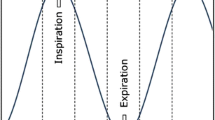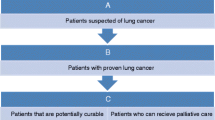Abstract
Purpose
The aim of our work is to evaluate the added diagnostic value of respiratory gated (4-D) positron emission tomography/computed tomography (PET/CT) in lung lesion detection/characterization in a large patient population of a multicentre retrospective study.
Methods
The data of 155 patients (89 men, 66 women, mean age 63.9 ± 11.1 years) from 5 European centres and submitted to standard (3-D) and 4-D PET/CT were retrospectively analysed. Overall, 206 lung lesions were considered for the analysis (mean ± SD lesions dimension 14.7 ± 11.8 mm). Maximum standardized uptake values (SUVmax) and lesion detectability were assessed for both 3-D and 4-D PET/CT studies; 3-D and 4-D PET/CT findings were compared to clinical follow-up as standard reference.
Results
Mean ± SD 3-D and 4-D SUVmax values were 5.2 ± 5.1 and 6.8 ± 6.1 (p < 0.0001), respectively, with an average percentage increase of 30.8 %. In 3-D PET/CT, 86 of 206 (41.7 %) lesions were considered positive, 70 of 206 (34 %) negative and 50 of 206 (24.3 %) equivocal, while in 4-D PET/CT 117 of 206 (56.8 %) lesions were defined as positive, 80 of 206 (38.8 %) negative and 9 of 206 (4.4 %) equivocal. In 34 of 50 (68 %) 3-D equivocal lesions follow-up data were available and the presence of malignancy was confirmed in 21 of 34 (61.8 %) lesions, while in 13 of 34 (38.2 %) was excluded. In 31 of these 34 controlled lesions, 20 of 34 (58.8 %) and 11 of 34 (32.4 %) were correctly classified by 4-D PET/CT as positive and negative, respectively; 3 of 34 (8.8 %) remained equivocal. With equivocal lesions classified as positive, the overall accuracy of 3-D and 4-D was 85.7 and 92.8 %, respectively, while the same figures were 80.5 and 94.2 % when equivocal lesions were classified as negative.
Conclusion
The respiratory gated PET/CT technique is a valuable clinical tool in diagnosing lung lesions, improving quantification and confidence in reporting, reducing 3-D undetermined findings and increasing the overall accuracy in lung lesion detection and characterization.


Similar content being viewed by others
References
Nehmeh SA, Erdi YE, Ling CC, Rosenzweig KE, Schoder H, Larson SM, et al. Effect of respiratory gating on quantifying PET images of lung cancer. J Nucl Med 2002;43:876–81.
Nehmeh SA, Erdi YE, Ling CC, Rosenzweig KE, Squire OD, Braban LE, et al. Effect of respiratory gating on reducing lung motion artifacts in PET imaging of lung cancer. Med Phys 2002;29:366–71.
Erdi YE, Nehmeh SA, Pan T, Pevsner A, Rosenzweig KE, Mageras G, et al. The CT motion quantitation of lung lesions and its impact on PET-measured SUVs. J Nucl Med 2004;45:1287–92.
Bettinardi V, Rapisarda E, Gilardi MC. Number of partitions (gates) needed to obtain motion-free images in a respiratory gated 4D-PET/CT study as a function of the lesion size and motion displacement. Med Phys 2009;36:5547–58.
Goerres GW, Kamel E, Seifert B, Burger C, Buck A, Hany TF, et al. Accuracy of image coregistration of pulmonary lesions in patients with non-small cell lung cancer using an integrated PET/CT system. J Nucl Med 2002;43:1469–75.
Pevsner A, Nehmeh SA, Humm JL, Mageras GS, Erdi YE. Effect of motion on tracer activity determination in CT attenuation corrected PET images: a lung phantom study. Med Phys 2005;32:2358–62.
Gould MK, Maclean CC, Kuschner WG, Rydzak CE, Owens DK. Accuracy of positron emission tomography for diagnosis of pulmonary nodules and mass lesions: a meta-analysis. JAMA 2001;285:914–24.
Degirmenci B, Wilson D, Laymon CM, Becker C, Mason NS, Bencherif B, et al. Standardized uptake value-based evaluations of solitary pulmonary nodules using F-18 fluorodeoxyglucose-PET/computed tomography. Nucl Med Commun 2008;29:614–22.
Kim SC, Machac J, Krynyckyi BR, Knesaurek K, Krellenstein D, Schultz B, et al. Fluoro-deoxy-glucose positron emission tomography for evaluation of indeterminate lung nodules: assigning a probability of malignancy may be preferable to binary readings. Ann Nucl Med 2008;22:165–70.
Lupi A, Zaroccolo M, Salgarello M, Malfatti V, Zanco P. The effect of 18F-FDG-PET/CT respiratory gating on detected metabolic activity in lung lesions. Ann Nucl Med 2009;23:191–6.
Werner MK, Parker JA, Kolodny GM, English JR, Palmer MR. Respiratory gating enhances imaging of pulmonary nodules and measurement of tracer uptake in FDG PET/CT. AJR Am J Roentgenol 2009;193:1640–5.
García Vicente AM, Soriano Castrejón AM, Talavera Rubio MP, León Martín AA, Palomar Muñoz AM, Pilkington Woll JP, et al. (18)F-FDG PET-CT respiratory gating in characterization of pulmonary lesions: approximation towards clinical indications. Ann Nucl Med 2010;24:207–14.
Boellaard R, O’Doherty MJ, Weber WA, Mottaghy FM, Lonsdale MN, Stroobants SG, et al. FDG PET and PET/CT: EANM procedure guidelines for tumour PET imaging: version 1.0. Eur J Nucl Med Mol Imaging 2010;37:181–200.
Kini VR, Vedam SS, Keall PJ, Patil S, Chen C, Mohan R. Patient training in respiratory-gated radiotherapy. Med Dosim 2003;28:7–11.
Otani Y, Fukuda I, Tsukamoto N, Kumazaki Y, Sekine H, Imabayashi E, et al. A comparison of the respiratory signals acquired by different respiratory monitoring systems used in respiratory gated radiotherapy. Med Phys 2010;37:6178–86.
Alkhawaldeh K, Bural G, Kumar R, Alavi A. Impact of dual-time-point (18)F-FDG PET imaging and partial volume correction in the assessment of solitary pulmonary nodules. Eur J Nucl Med Mol Imaging 2008;35:246–52.
Conflicts of interest
None.
Author information
Authors and Affiliations
Corresponding author
Rights and permissions
About this article
Cite this article
Guerra, L., De Ponti, E., Elisei, F. et al. Respiratory gated PET/CT in a European multicentre retrospective study: added diagnostic value in detection and characterization of lung lesions. Eur J Nucl Med Mol Imaging 39, 1381–1390 (2012). https://doi.org/10.1007/s00259-012-2148-2
Received:
Accepted:
Published:
Issue Date:
DOI: https://doi.org/10.1007/s00259-012-2148-2




